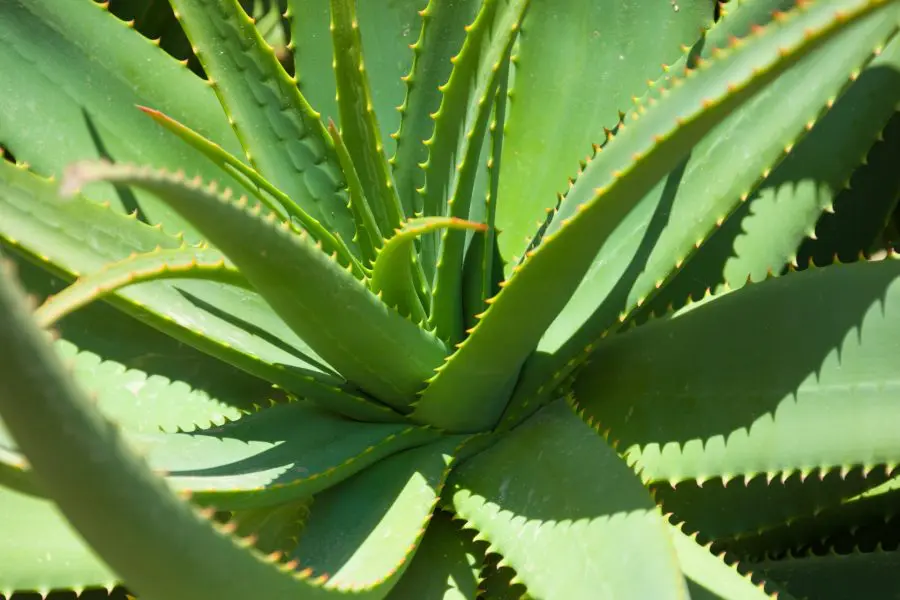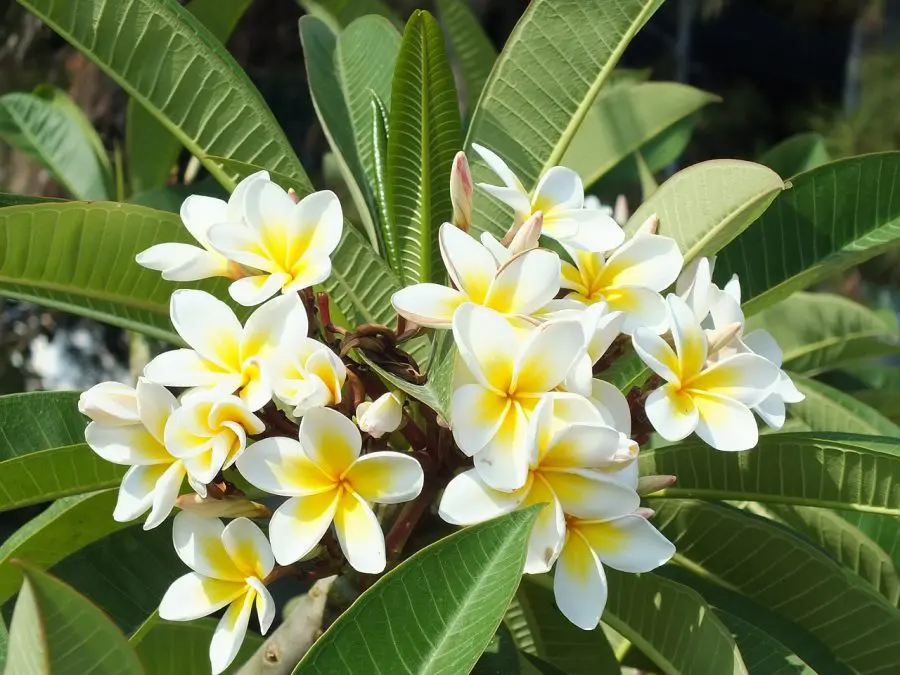This post contains affiliate links. If you buy something from one of our links we may earn a commission. Thanks

Discover the secrets of how to care for aloe plants indoors with our comprehensive guide, offering expert tips and advice for a thriving aloe in your home.
To care for Aloe plants indoors, place them in a bright, sunny window for optimal light exposure. Water the plant only when the soil is completely dry, typically every 2-4 weeks. Use a well-draining potting mix and a pot with drainage holes to prevent root rot. No need for frequent fertilization; doing so once a year is sufficient.
Are you looking to add a touch of green to your indoor space? Aloe plants are a perfect choice!
In this guide, we’ll explore how to care for aloe plants indoors, ensuring they thrive and brighten up your home.
With their myriad of benefits and low-maintenance requirements, aloe plants are the ideal companions for both new and experienced indoor gardeners.
So, let’s dive in and learn about aloe vera care to keep these charming, spiky friends happy and healthy!
How to Care for Aloe Plants Indoors: A Comprehensive Guide
Welcome to our comprehensive guide on indoor aloe plant care! If you’re considering adding this versatile, low-maintenance plant to your home or have recently brought one in, you’ve come to the right place.
Navigating the Aloe Vera Indoor Care Guide
In this blog post, we’ll walk you through the ins and outs of caring for your aloe vera plant indoors.
By the end, you will know how to care for an aloe vera plant indoors.
We’ll cover a range of topics and Aloe plant care tips to ensure your aloe plants thrive indoors.
From understanding the benefits of aloe vera to finding the perfect balance of light and water, we’ll discuss everything you need to know about soil, pots, fertilizing, temperature, humidity, and more.
Plus, we’ll explore maintenance, pruning, repotting, propagation, and tackling common pests and diseases.
So, let’s get started on our journey to nurturing happy and healthy aloe plants indoors!
The Impact of Indoor Plants on Our Well-being
Indoor plants hold a special place in our lives, offering numerous benefits that extend beyond their aesthetic appeal.
They not only improve air quality by filtering out pollutants but also contribute to our mental well-being by reducing stress and boosting mood.
Surrounding ourselves with greenery can create a calming environment and even enhance productivity, making indoor plants an excellent addition to our homes and workspaces.
Aloe Vera: A Star Among Indoor Plants
Aloe vera has gained popularity as an indoor plant choice for good reason. Its unique, spiky appearance adds character to any space, and its low-maintenance nature makes it easy to care for.
Aloe vera is also prized for its medicinal properties, as its gel can be used to soothe burns and promote skin health.
As a versatile and hardy plant, aloe vera is well-suited to a variety of indoor conditions, making it an ideal choice for both new and experienced gardeners.
According to Wikipedia
Aloe vera is a succulent plant species of the genus Aloe. It is widely distributed, and is considered an invasive species in many world regions.
An evergreen perennial, it originates from the Arabian Peninsula, but grows wild in tropical, semi-tropical, and arid climates around the world. It is cultivated for commercial products, mainly as a topical treatment used over centuries. The species is attractive for decorative purposes, and succeeds indoors as a potted plant.
It is used in many consumer products, including beverages, skin lotion, cosmetics, ointments or in the form of gel for minor burns and sunburns. There is little clinical evidence for the effectiveness or safety of Aloe vera extract as a cosmetic or topical drug, and oral ingestion has risk of toxicity.
Aloe Vera Indoor Plant Benefits
Let’s dive into the wonderful world of aloe vera indoor plant benefits!
You may already be familiar with some of the ways these spiky green beauties contribute to our lives, but there’s more to aloe vera plants than meets the eye.
In this section, we’ll delve into the various advantages of having an aloe vera plant indoors, from air purification to medicinal uses and, of course, their delightful appearance.
So, grab a cup of tea, get cozy, and join us as we uncover the reasons why aloe vera plants are such beloved additions to our indoor spaces.
Breathe Easier: Air Purification
One of the many perks of having an aloe vera plant indoors is its air purifying abilities.
These green companions help filter out harmful pollutants like formaldehyde and benzene, commonly found in household items and products.
By purifying the air, aloe vera plants create a healthier living environment for you and your loved ones, making it easier to breathe and contributing to overall well-being.
Healing Powers: Medicinal Properties
Aloe vera plants have been used for their medicinal properties for centuries.
The aloe gel found inside their fleshy leaves is known for its soothing and healing qualities.
It can be applied topically to treat minor burns, sunburns, and skin irritations, as well as to moisturize and promote skin health.
With an aloe vera plant right at your fingertips, you’ll have a natural remedy on hand for various skin ailments.
A Touch of Charm: Aesthetic Appeal
Beyond their practical benefits, aloe vera plants also serve as a visually appealing addition to your indoor space.
With their unique, spiky leaves and sculptural form, they effortlessly bring life and character to any room.
Aloe vera plants are versatile in terms of design, complementing various styles and themes, from minimalist to bohemian.
Adding an aloe vera plant to your home can elevate your interior decor while providing an inviting, vibrant atmosphere.
Can We Keep Aloe Vera Plant at Home – Plant Size
Are you wondering if an aloe vera plant would be a good fit for your home?
The good news is that these charming plants are perfect for keeping indoors, even in smaller spaces!
In this section, we’ll discuss the ideal size for an aloe vera plant at home and share some tips on where to place your new green friend.
With the right knowledge, you’ll be able to find the perfect spot for your aloe vera plant, ensuring it becomes a treasured part of your home for years to come.
Just the Right Size: Ideal Size for Indoor Aloe Plants
Aloe vera plants come in various sizes, but most indoor varieties tend to be compact and manageable.
The typical size of an indoor aloe plant ranges from 12 to 24 inches in height and width, making it a great option for various living spaces.
As your aloe plant grows, it will require some attention and care, but its moderate size ensures it won’t take over your home.
This adaptable nature is one of the many reasons aloe vera plants are loved by indoor gardeners.
Finding the Perfect Spot: Suitable Locations for Placement
Choosing the right location for your aloe vera plant is crucial for its health and happiness.
These plants prefer bright, indirect light, so placing them near a south or west-facing window is ideal.
Be cautious of direct full sun, as it can cause the leaves to turn brown or become sunburned.
Aloe vera plants can also tolerate lower light conditions but without enough light, they may grow more slowly.
If you’re short on window space, you can try to place your plant in a brighter spot inside a brightly lit room, making sure it still receives adequate light.
By finding the perfect balance of light exposure, you’ll be well on your way to enjoying a thriving aloe vera plant in your home.
Light – Aloe Vera Too Much Sun?
Finding the right balance of sunlight for your aloe vera plant can be a bit tricky, but don’t worry, we’re here to help!
In this section, we’ll discuss the ideal light conditions for your indoor aloe and how to recognize the signs of too much or too little sunlight.
With a little know-how and some careful observation, you’ll be able to create the perfect environment for your aloe plant to flourish.
So, let’s shed some light on this topic and make sure your aloe vera plant receives just the right amount of sunshine!
Striking the Balance: Ideal Light Conditions
Aloe vera plants thrive in bright light, which means they enjoy being near a window with filtered or diffused light.
A South-facing window or a west-facing window is typically the best choice for providing the right amount of light without the risk of sunburn.
However, if you don’t have access to such a window, you can still place your aloe in a well-lit room, ensuring it receives adequate light throughout the day.
Reading the Signs: Too Much or Too Little Sunlight
Paying attention to your aloe vera plant’s appearance can help you determine if it’s receiving the right amount of sunlight.
Signs of too much direct sunlight include browning or sunburned leaves, which can appear as dry, discolored, or wilted spots.
On the other hand, insufficient sunlight may cause your aloe plant to become leggy or have pale leaves, as it stretches toward the light source.
Fine-Tuning Light Exposure: Adjusting Light Exposure
If you notice any of the signs mentioned above, it’s time to adjust your aloe vera plant’s light exposure.
For plants receiving too much direct sunlight, try moving them to a location with more diffused light, such as a few feet away from the window or behind a sheer curtain.
If your plant isn’t getting enough sunlight, move it closer to a bright window or consider using artificial light. A full-spectrum LED grow light can help supplement natural light.
Regularly monitoring your aloe vera plant and adjusting its light exposure as needed will help ensure healthy aloe vera plants.
Watering – How Much Water Does an Aloe Plant Need?
Watering your aloe plant might seem like a simple task, but finding the right balance is key to its well-being.
In this section, we’ll delve into the world of aloe plant hydration, discussing how much water your green friend needs and how to recognize the signs of overwatering or underwatering.
With the right guidance and a little attention to detail, you’ll soon become a pro at keeping your aloe vera plant perfectly quenched and content.
So, let’s dive in and make sure your aloe stays happy and hydrated!
Stay on Schedule: Recommended Watering Routine
Aloe vera plants are known for their drought-tolerant nature, which means they don’t require frequent watering.
As a general rule, it’s best to water your aloe plant every two to three weeks during warmer months and every four to six weeks in cooler months.
Make sure the soil is completely dry before watering, as this will help prevent root rot.
Remember, it’s better to err on the side of underwatering than overwatering, as aloe plants can recover more easily from dry soil conditions.
Reading the Leaves: Signs of Overwatering or Underwatering
To keep your aloe plant in tip-top shape, it’s essential to recognize the signs of overwatering or underwatering.
Overwatered aloe plants may have yellowing, mushy leaves, and may even show signs of root rot.
Underwatered plants, on the other hand, will display dry, wrinkled, or curled leaves. By keeping an eye on your plant’s appearance, you can adjust your watering routine accordingly and ensure it remains healthy.
Watering Techniques: Top or Bottom Watering?
When it comes to watering your aloe vera plant, the method you choose can make a difference.
Bottom watering is generally preferred over top watering and provides the best results, as it helps prevent leaf rot and other moisture-related issues.
Here’s a quick guide on how to bottom water your aloe plant:
• Place your potted aloe vera in a shallow dish or tray filled with water.
• Allow the plant to absorb water through the drainage holes at the bottom of the pot.
• You’ll know it’s working when the top of the soil becomes visibly moist.
• Remove your aloe plant from the dish once the soil is sufficiently damp, usually within 20-30 minutes, and let any excess water drain away.
By using the bottom watering technique, you’ll keep the leaves and crown of your aloe plant dry while still providing the necessary moisture for the roots, promoting a healthy and happy plant.
Soil and Pots – Best Soil for Aloe Vera Plant Indoors: Coco Coir and Perlite
Finding the perfect soil and pot for your indoor aloe vera plant is essential for its overall health and happiness.
In this section, we’ll discuss the best soil mix for your aloe plant, focusing on the benefits of using coco coir and perlite.
We’ll also touch on the importance of choosing the right pot to ensure proper drainage and root development.
With the right combination of soil and pot, your aloe vera plant will have a strong foundation to thrive and grow.
So, let’s get started on setting up your aloe plant’s new home!
The Dynamic Duo: Benefits of Using Coco Coir and Perlite
Coco coir and perlite make an excellent soil mix for aloe vera plants, as they offer the perfect balance of moisture retention and drainage.
Coco coir, made from coconut husks, has excellent water-holding capabilities, while perlite, a lightweight volcanic rock, ensures proper aeration and drainage.
Together, these ingredients create a well-draining soil mix that prevents root rot and provides the ideal environment for your aloe plant’s roots to grow.
Crafting the Perfect Mix: Mixing Your Own Soil Blend
• To create the best soil mix for your aloe vera plant, combine equal parts of coco coir and perlite.
• You can also add a small amount of well-aged compost or worm castings for added nutrients.
• This blend ensures that your aloe plant’s roots have access to the moisture and nutrients they need while preventing overwatering.
• When mixing your own soil blend, be sure to mix the ingredients thoroughly to achieve a uniform consistency.
• If you decide to try and use regular potting soil you should add additional perlite to promote better drainage. Instead using cactus soil is a better alternative.
Picking the Perfect Home: Choosing the Right Pot
The right pot is just as important as the perfect soil mix for your aloe vera plant.
Choose a pot with drainage holes to allow excess water to escape, preventing root rot.
Terra cotta pots are an excellent choice for aloe plants, as they are porous and help to wick away excess moisture from the soil.
When selecting a pot size, pick one that is slightly larger than the root ball, allowing your aloe plant room to grow without becoming rootbound.
By choosing the right pot, you’ll provide your aloe plant with a comfortable and healthy environment to thrive.
Fertilizing
While aloe vera plants are low-maintenance and can grow well without much fuss, they still appreciate a little boost now and then.
In this section, we’ll discuss the ins and outs of fertilizing your indoor aloe plant, covering everything from the types of fertilizer to use to the ideal fertilizing schedule.
With the right knowledge and approach, you can ensure your aloe vera plant has all the nutrients it needs to grow strong and healthy.
So, let’s dig into the world of fertilizing and help your aloe plant reach its full potential!
Timing is Key: When to Fertilize
The best time to fertilize your aloe vera plant is during its active growing season, which typically runs from spring to late summer.
During this period, fertilizing your aloe plant once every four to six weeks is ideal.
It’s important to avoid fertilizing during the winter months, as this is the plant’s dormant period, and additional nutrients are not necessary.
Picking the Right Fuel: Types of Fertilizer to Use
When choosing a fertilizer for your aloe vera plant, look for a balanced, water-soluble, or liquid fertilizer.
A formula with an even ratio of nitrogen, phosphorus, and potassium (such as 10-10-10 or 20-20-20) works well.
You can also opt for an organic fertilizer like worm castings or fish emulsion for a more natural approach.
Whatever you choose, be sure to follow the package instructions, as using too much fertilizer can harm your plant.
Feeding Your Plant: How to Apply Fertilizer
Applying fertilizer to your aloe vera plant is simple. If using a water-soluble or liquid fertilizer, dilute the fertilizer according to the package instructions, then water your plant with the fertilizer solution.
Be sure to apply the fertilizer to the soil, avoiding the leaves and the center of the plant.
If using an organic fertilizer like worm castings, sprinkle a thin layer on the surface of the soil and gently work it in.
By properly applying fertilizer, you’ll provide your aloe vera plant with the essential nutrients it needs to grow and thrive.
Temperature and Humidity
Creating a comfortable environment for your aloe vera plant is crucial to its overall health and happiness, and that includes paying attention to temperature and humidity levels.
In this section, we’ll explore the ideal temperature and humidity ranges for your indoor aloe plant, as well as tips on how to maintain a consistent and suitable environment.
With the right guidance, you’ll be able to create the perfect microclimate for your aloe vera plant, ensuring it thrives all year round.
So, let’s talk temperature and humidity and keep your aloe plant cozy and content!
Comfort Zone: Ideal Temperature Range
Aloe vera plants prefer a temperature range between 55 and 80°F (13 and 27°C), making them well-suited for most indoor environments.
They can tolerate minor fluctuations, but it’s important to avoid exposing your plant to extreme temperatures or sudden changes.
Keep your aloe plant away from cold drafts, heating vents, or direct sources of heat, as these can cause stress and damage to the plant.
Just Right: Ideal Humidity Levels
Aloe vera plants are native to arid regions, which means they can thrive in low humidity environments.
Indoor humidity levels between 40% and 60% are generally suitable for aloe plants.
They can tolerate lower humidity levels, but it’s essential to monitor your plant’s appearance for signs of dehydration, such as brown leaf tips or wrinkling.
Steady and Stable: Tips for Maintaining Optimal Conditions
To maintain optimal temperature and humidity levels for your aloe vera plant, follow these simple tips:
• Place your plant in an area away from cold drafts, direct sunlight, or heat sources.
• Use a thermometer and hygrometer to monitor the temperature and humidity in your plant’s environment.
• Adjust the temperature and humidity as needed by using a humidifier, or dehumidifier, or adjusting your home’s heating and cooling systems.
• Regularly check your plant for signs of stress or damage and make adjustments to its environment as necessary.
By following these guidelines, you’ll help ensure your aloe plant remains comfortable and healthy in its indoor environment.
Maintenance and Pruning
While aloe vera plants are relatively low-maintenance, a little care and attention can go a long way in keeping them looking their best.
In this section, we’ll discuss maintenance and pruning tips for your indoor aloe plant, including how to remove dead or damaged leaves and encourage healthy growth.
By incorporating these simple practices into your plant care routine, you’ll keep your aloe looking lush and vibrant while promoting its overall well-being.
So, let’s grab those pruning shears and give your aloe plant the TLC it deserves!
Timely Trimming: When and How to Prune
The best time to prune your aloe vera plant is during its active growing season, typically between spring and the late summer months.
Pruning involves removing dead, damaged, or overcrowded leaves, as well as trimming back any leggy growth.
To prune, simply cut off the unwanted leaves at their base, taking care not to damage the surrounding healthy foliage.
Regular pruning not only keeps your plant looking tidy but also encourages new growth and prevents overcrowding.
Shear Success: Tools and Techniques for Pruning
When it comes to pruning your aloe vera plant, having the right tools makes all the difference.
A pair of clean, sharp pruning shears or scissors is essential for making clean, precise cuts.
To avoid spreading disease or damaging your plant, be sure to sanitize your tools before and after each use.
When cutting, make sure to trim as close to the base of the leaf as possible without injuring the plant’s main stem.
Happy and Healthy: Ensuring a Healthy Plant
Regular maintenance and pruning play a significant role in keeping your aloe vera plant healthy.
By removing dead or damaged leaves, you help prevent the spread of disease and create room for new growth.
Additionally, proper pruning can improve air circulation around your plant, reducing the risk of pests and fungal infections.
By incorporating these simple care practices into your routine, you’ll ensure your aloe vera plant remains vibrant, healthy, and ready to bring beauty and benefits to your indoor space.
Repotting Aloe Vera
Repotting your aloe vera plant is an essential step in ensuring its continued growth and well-being.
Over time, your aloe plant may outgrow its current pot or require fresh soil to thrive.
In this section, we’ll guide you through the repotting process, discussing when to repot, how to choose the right pot and soil, and the best techniques for a successful transition.
With a little know-how and a gentle touch, you’ll have your aloe plant settled into its new home in no time.
So, let’s dive into the world of repotting and give your aloe vera plant the fresh start it deserves!
Time for a Change: Signs Your Aloe Plant Needs Repotting
Your aloe vera plant may need repotting if you notice any of the following signs:
• Rootbound: Roots growing out of a drainage hole or circling the surface of the soil.
• Overcrowded: Multiple pups (offshoots) competing for space and nutrients.
• Stunted growth: The plant has stopped growing or is growing very slowly despite proper care.
By repotting your aloe plant when needed, you’ll ensure it has the room and resources to continue growing strong and healthy.
Perfect Pairings: Choosing the Right Pot and Soil Mix
When repotting your aloe vera plant, it’s essential to choose the right pot and soil mix.
As mentioned earlier, a well-draining soil mix of equal parts coco coir and perlite works well for aloe plants.
When selecting a new pot, choose one that is slightly larger than the current pot, with drainage holes to prevent root rot.
Terra cotta pots are an excellent choice, as they provide good drainage and aeration.
Making the Move: Repotting Process Step-by-Step
Follow these steps to repot your aloe vera plant successfully:
• Gently remove the plant from its current pot, being careful not to damage the roots.
• Inspect the roots for any signs of disease or rot, and trim away any damaged or dead roots.
• Fill the new pot with your prepared soil mix, leaving enough space for the plant’s root ball.
• Place the aloe plant in the center of the new pot, ensuring the base of the leaves sits just above the soil line.
• Gently fill in the space around the root ball with more soil mix, pressing down lightly to eliminate air pockets.
• Water your newly repotted aloe plant thoroughly, allowing excess water to drain through the holes in the pot.
By following these repotting steps, you’ll provide your aloe vera plant with the space and fresh soil it needs to continue thriving.
Propagation – Aloe Vera Pups
One of the joys of caring for an aloe vera plant is watching it produce little offshoots, or pups, which can be easily propagated to grow new plants.
In this section, we’ll walk you through the process of propagating aloe vera pups, from identifying and removing the pups to planting and nurturing them into independent plants.
With a little patience and care, you’ll soon have a whole family of aloe plants to enjoy or share with friends.
So, let’s jump into the world of aloe vera propagation and learn how to multiply the beauty and benefits of these delightful plants!
Spot the Sprouts: Identifying Pups
Aloe vera pups are small offshoots that grow at the base of the mother plant.
These baby plants often appear as miniatures of the parent plant, with their own roots and leaves.
Pups are typically ready for propagation once they have developed several leaves and reached about one-third to half the size of the mother plant.
Keep an eye on your aloe plant, and when you notice these little ones sprouting up, it’s time to propagate!
Gentle Separation: How to Remove Pups from the Mother Plant
To remove aloe pups from the mother plant, follow these steps:
• Gently dig around the base of the pup, exposing the roots and the point where it connects to the mother plant.
• Carefully loosen the soil around the pup’s roots, using your fingers or a small gardening tool.
• Gently separate the pup from the mother plant, either by pulling it away or using a clean, sharp knife to cut the connection.
• Some people allow the pup to sit in a shady spot for a day or two, letting the cut end dry and form a protective callus.
I don’t think this is necessary. I prefer to plant it immediately after separation.
New Beginnings: Planting and Caring for New Aloe Plants
To plant and care for your new aloe plants, follow these guidelines:
• Fill a small pot with the recommended soil mix of equal parts coco coir and perlite.
• Create a shallow hole in the center of the soil, and place the pup’s roots inside, ensuring the base of the leaves is just above the soil line.
• Gently press the soil around the pup’s roots to secure it in place.
• Allow the newly planted pup to settle for a few days before watering. Then, follow the same care guidelines as for mature aloe plants, including proper watering, light, and temperature.
Exploring Alternatives: Other Methods
While pups are the most common method for propagating aloe vera plants, you can also try leaf cuttings.
However, this method is less reliable and may not always result in successful propagation.
To propagate using leaf cuttings, simply cut a healthy leaf from the mother plant, allow it to callus for a few days, and then plant the cut end in a well-draining soil mix.
Keep the soil slightly moist, and with luck, the cutting may root and grow into a new plant.
Pests and Diseases – Aloe Vera Plant Care Problems
Even the most attentive plant caregivers may encounter pests or diseases from time to time.
In this section, we’ll explore common aloe vera plant care problems, including pests and diseases that may affect your beloved plant.
By learning how to identify, prevent, and treat these issues, you can ensure your aloe plant continues to thrive and provide you with its many benefits.
So, let’s delve into the world of plant pests and diseases, and arm ourselves with the knowledge needed to keep our aloe plants healthy and happy!
Unwanted Visitors: Common Pests and Diseases
Some common pests and diseases that may affect your aloe vera plant:
Pests: Mealybugs, spider mites, and scale insects can cause damage to your aloe plant by feeding on its sap and weakening it.
Diseases: Root rot, a fungal infection, is often caused by overwatering and poor drainage, while leaf rot may result from excessive moisture on the leaves.
Other issues: Yellowing or browning leaves can be signs of overwatering, underwatering, or exposure to extreme temperatures.
Staying Ahead: Preventative Measures
Taking a few preventative measures can help keep pests and diseases at bay:
• Ensure proper watering, light, and temperature conditions for your aloe plant.
• Use a well-draining soil mix and pots with drainage holes to prevent standing water.
• Regularly inspect your plant for any signs of pests or diseases, catching problems early before they worsen.
• Maintain good air circulation around your plant to discourage pests and fungal infections.
Restoration and Recovery: Treatment Options
If your aloe vera plant does encounter pests or diseases, take the following steps to treat the problem:
• For pests, remove them manually or use a cotton swab dipped in rubbing alcohol to wipe them off. For more severe infestations, consider using an insecticidal soap or neem oil.
• If you suspect root rot, remove the plant from its pot, trim away any affected roots, and repot it in fresh, well-draining soil. Be sure to let the plant dry out between waterings.
• For leaf rot, trim away affected leaves and reduce humidity around the plant, ensuring that the leaves remain dry.
• Address yellowing or browning leaves by adjusting your plant’s watering schedule or moving it to a more suitable location.
By identifying, preventing, and treating common aloe vera plant care problems, you can help your plant stay healthy and continue to thrive in your indoor environment.
Aloe Plant FAQs
Aloe plants have long been a favorite for indoor gardeners due to their unique look and medicinal properties.
These succulents are well-suited for indoor conditions if provided with adequate care.
Even though aloe plants are relatively low-maintenance, there are still best practices to ensure they remain healthy and vibrant.
Whether you’ve recently acquired an aloe plant or are looking to troubleshoot some care issues, this FAQ section is designed to answer some of your most pressing questions.
Q: How do you keep an indoor aloe plant alive?
A: To keep an indoor aloe plant alive, place it in a location with bright, indirect sunlight and water it sparingly, only when the soil is completely dry. A well-draining pot and soil are also essential.
Q: Do aloe plants need direct sunlight?
A: While aloe plants appreciate bright light, they can be sensitive to prolonged direct sunlight. Indirect sunlight or some hours of direct morning light are generally more suitable for them.
Q: How often do you water an aloe plant?
A: Water an aloe plant only when the soil is completely dry, which is usually every 2-4 weeks. Overwatering can lead to root rot.
Q: Do aloe plants need sun and water?
A: Yes, aloe plants need both sun and water, but in moderation. They thrive in bright, indirect sunlight and need water only when the soil is dry.
Q: How do you know if aloe vera is overwatered?
A: Signs of overwatering include yellow, mushy leaves and root rot. If the plant appears unhealthy and the soil is consistently wet, you may be overwatering.
Q: Do aloe plants like wet or dry soil?
A: Aloe plants prefer dry soil and are susceptible to root rot if kept in wet conditions. Allow the soil to dry out completely between watering sessions.
Taking care of an aloe plant is relatively straightforward, but it’s important to meet its specific needs for sunlight and water.
By adhering to these guidelines, you’ll ensure that your aloe plant remains a thriving member of your indoor garden.
How To Care For Aloe Plants Indoors Final Thoughts
As we wrap up our comprehensive guide on how to care for aloe plants indoors, we hope you’ve found all the tips and insights you need to help your aloe vera plant thrive in your home.
From understanding the numerous benefits of aloe plants to mastering the ins and outs of watering, light, soil, and more, you’re now equipped to provide the best possible care for your leafy companion.
Remember, a happy aloe plant not only adds beauty and charm to your living space but also offers a range of health benefits.
So, with your newfound knowledge, enjoy nurturing your aloe plant, and watch it grow and flourish by your side!
In A Nutshell: Recap of Key Points
Let’s take a moment to revisit the most important aspects of indoor aloe plant care:
• Benefits: Air purification, medicinal properties, and aesthetic appeal.
• Plant size and placement: Suitable for home environments and easy placement.
• Light requirements: Bright, indirect sunlight.
• Watering: Bottom watering is preferred, with careful attention to avoid overwatering or underwatering.
• Soil and pots: A mix of coco coir and perlite in a well-draining pot.
• Fertilizing: Occasional feeding during the growing season.
• Temperature and humidity: Maintain a comfortable room temperature and moderate humidity.
• Maintenance and pruning: Regular grooming and removal of damaged leaves.
• Repotting: As needed when the plant outgrows its pot.
• Propagation: Through pups or leaf cuttings.
• Pests and diseases: Monitor and address any issues that arise.
Green Thumbs Up: Encouragement for Aloe Vera Plant Indoor Care
With all the information and tips shared in this guide, you’re well-prepared to care for your aloe plant indoors successfully.
As you apply the knowledge you’ve gained, remember that practice makes perfect.
If you encounter any challenges along the way, don’t be discouraged; instead, use the experience to learn and grow as a plant caregiver.
In time, you’ll find yourself enjoying the company of a healthy and thriving aloe plant, reaping its many benefits, and sharing your passion for indoor gardening with others. Happy planting!
Read more: 10 Benefits Of Succulent Plants Indoors [Plus They’re Easy To Grow]





















